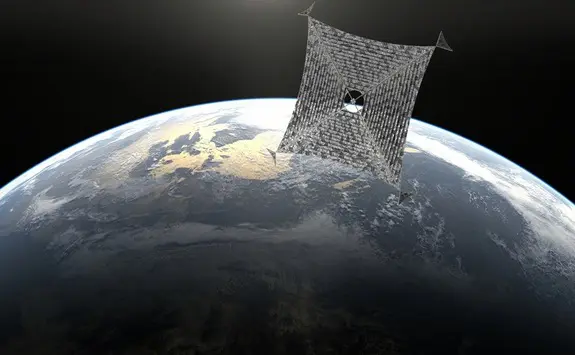A new method of space travel is about to get its moment in the sun.
Several upcoming missions aim to harness the subtle push of sunlight, using gossamer “solar sails” to cruise through the heavens like boats through the sea. Such propellant-free propulsion could take craft cheaply and efficiently to a variety of destinations, from locations in near-Earth space to the edge of the solar system and beyond, advocates say.
A spacecraft equipped with a sail 1,300 feet (400 meters) wide, for example, could travel 1.3 billion miles (2.1 billion kilometers) per year, allowing it to escape the sun’s sphere of influence in just a decade or so, according to researchers behind the Interstellar Probe, a NASA concept mission proposed about 15 years ago.
“There’s nothing known to us now that could actually attain that kind of a speed using chemical propulsion,” aerospace engineer Bruce Campbell said last week during a presentation with NASA’s Future In-Space Operations (FISO) working group.
Paving the way
Solar radiation pressure provides a very small push to a spacecraft. But this push is continuous and can thus accelerate a probe to tremendous speeds over time.
Harnessing sunlight in this way is not a new idea. Jules Verne mentioned the possibility in his 1865 book “From the Earth to the Moon,” and Arthur C. Clarke wrote about a solar-sailing spaceship race a century later, in the 1964 short story “Sunjammer.”
But it took a long time for solar sails to go from concept to reality. The first successful demonstration of the propulsion system didn’t come until 2010, when Japan’s Ikaros probe deployed its 46-foot-wide (14 m) sail and became the first craft ever to cruise through space on the backs of photons.
NASA followed suit five months later, launching the tiny NanoSail-D demonstrator to Earth orbit in November 2010. NanoSail-D unfurled its sail in January 2011, then circled the planet for eight months before burning up in the atmosphere.
Other projects now loom on the horizon, building momentum for the technology. A big milestone should come in early 2016, when NASA plans to launch the largest-ever solar sail to space.
The $27 million Sunjammer mission, which takes its name from the Arthur C. Clarke story, will use a sail built by California-based company L’Garde that measures 124 feet (38 m) on a side. The sail, made of an advanced material called Kapton, is just 5 microns (about 0.0002 inches) thick. It weighs less than 70 pounds (32 kilograms) and packs down to the size of a dishwasher, NASA officials have said.
The current plan calls for outfitting Sunjammer with some sun-monitoring instruments and sending it out to a spot about 1.8 million miles (3 million km) from Earth, along the Earth-sun line. That’s twice as far away as the Earth-sun Lagrange Point 1 (L1), a gravitationally stable spot in space that has hosted various heliophysics and space-weather missions over the years.
“What we intend to do with Sunjammer is demonstrate that a solar sail is an opportune device to place solar-warning instruments closer toward the sun than is currently allowed with just conventional systems at L1,” L’Garde president Nathan Barnes said during a FISO talk in February.
If you’d like to learn more about Astronomy, check out this article.
Read the full article here.








